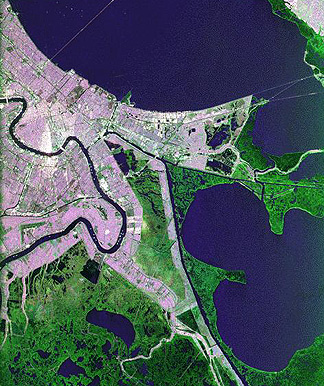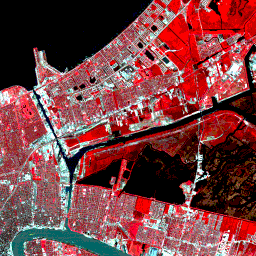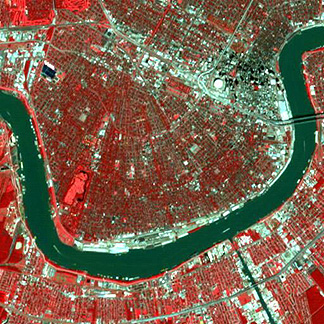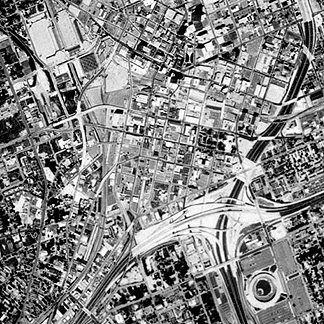To start, we will establish a framework for the Miami metropolis by looking at our first Landsat mosaic (others are treated in Section 7) constructed from several indivdual TM scenes, each rendered in quasi-natural color.
This mosaic extends from the Florida Keys at the bottom to the Orlando area of the central state at the top. To the east is Cape Canaveral, site of all manned and many unmanned NASA launches. Having now set up your bearings, we encourage you to look for these features in the mosaic, using a convenient atlas: The Tampa-St. Petersburg area around Tampa Bay; Fort Myers; Sanibel Island; Lake Okeechobee; the Everglades; Alligator Alley; Fort Lauderdale; the greater Miami region. The famed Everglades is essentially a spread-out "river" of sluggish drainage flowing over sink depressions through a vast expanse of sawgrass and hammocks ("tree islands", seen here as elongate red patches) of hardwoods. Along the south coast are mangrove swamps and marshes. An extensive farm region has been cultivated in reclaimed land between Lake Okeechobee and the northern edge of the present Everglades. The widely dispersed lake country in central Florida develops from sinkholes and other internal drainage features in the limestone bedrock.
Next, look at this false-color Landsat TM subscene that covers the Miami area and much of the Florida Gold Coast through West Palm Beach up to Fort Lauderdale.
The city and its suburbs generally hug the coastline, being prevented so far from spreading inland by the eastern edge of the Everglades. The elongate red features that seem to follow curvilinear tracks are hammocks whose distribution is influenced by water flow patterns; linear red features are sloughs dredged by engineers to better control flow. The offshore bar that makes up Miami Beach is conspicuous. The slant linear feature passing through Miami is the Miami Canal that parallels Route 27. Reclaimed swamplands to the north are now the sites of large farm tracts.
Turning to New Orleans, lets set the city into context with its surroundings by looking at two images. At the top is a full Landsat MSS image in which the city appears in the upper left between Lake Ponchatrain and meanders of the Mississippi River. This January 1973 scene is dominated by the "birds-foot" distributaries and bayous of the Mississippi Delta, set off by the subdued false color reds of the swampy vegetation in moderate winter dormancy, and by the pronounced chalky blue of sediments from the river as it empties at the currently active distributary. On the bottom is a closer look consisting of a multi-band (with RGB color assignments) SIR-C radar image, taken from the Space Shuttle on October 2, 1994. Compare the two, noting both similarities and differences.

Next look at the TM false color composite that is a subset from the Landsat 5 scene obtained on March 24, 1985.

Remember that the resolution is 30 meters (97 feet). The subscene covers a part of the eastern half of the "Crescent City" starting with just a bit of the world-famous French Quarter, at the bottom left corner of the image (Bourbon Street near the Cathedral of St. Louis just enters there), that extends back from the docks along the Mississippi River (its powder blue color results from its high silt content that imparts increased reflectance in band 2). Many of the city streets are spaced to form true square blocks. Some of the larger buildings in this scene are resolvable at TM's 30 m. resolution. The reds even in the city proper are signs of the luxuriant vegetation that is profuse throughout this lovely city. The large body of water, at the top, is the south shore of Lake Pontchartrain, a 57 km (35 mile) wide (1619 sq. km; 625 sq. mile) inland brackish (mildly salty) lake that connects by a eastward channel to Lake Borgne, a saltwater body joined with the Mississippi Sound to the Gulf of Mexico. Running through the city is part of the Gulf Intracoastal Waterway, a continuous 1725 km (1065 mile) long water route from Carrabelle, Florida to Brownsville, Texas that also connects with the Mississippi to provide a protected canal-like passageway for pleasure boats and freight barges. Where it doesn't utilize the open Gulf, the waterway is cut inland from the shore to an average depth of 3.7 m (12 ft) and width of 38 m (125 ft). This waterway also merges in the scene with the Inner Harbor Navigation Canal that joins Lake Pontchartrain to the Mississippi; note the wharfs along it. Interstate 10 runs eastward here passing through the Gentilly section of New Orleans. Highway 46 follows the river through the suburb of Chalmette. To its north is a large swampy area, or bayou, in St. Bernard Parish; much of this area is heavily vegetated but open water (blackish) takes up most of the interior. The New Orleans Lakefront Airport juts out into Pontchartrain. Green areas to its southwest are Pontchartrain Park and the University of New Orleans campus.
Now look at another view of central New Orleans, lying mainly to the southwest of the Landsat subscene. This subscene, about 9 km (6 miles) on a side, shows the city at 10 meters resolution, as imaged by the multispectral scanner on JERS-1, a Japanese satellite launched in 1992. Note the radial pattern of the streets that act like spokes against the crescent bend of the Mississippi River. The large white round feature is the Superdome, site of several football Superbowls. Tall buildings in the downtown are just to its right. The dark patch nearby is astride the Vieux Carre or French Quarter.

Obviously, even more information about an urban center will result from still higher resolution. This next subscene shows part of central Atlanta, GA, as imaged by the Kosmos 2-meter KVR-1000 film camera flown on the Russian MIR Space Station. This space photo has many of the qualities and detail of aerial photos. Features of interest include the Atlanta-Fulton Co. Stadium, until 1997 home of the Braves baseball team, and the complex intersection of Interstates 20 (E-W) and 75-85 (N-S).

Code 935, Goddard Space Flight Center, NASA
Written by: Nicholas M. Short, Sr. email: nmshort@epix.net
and
Jon Robinson email: Jon.W.Robinson.1@gsfc.nasa.gov
Webmaster: Bill Dickinson Jr. email: rstwebmaster@gsti.com
Web Production: Christiane Robinson, Terri Ho and Nannette Fekete
Updated: 1999.03.15.